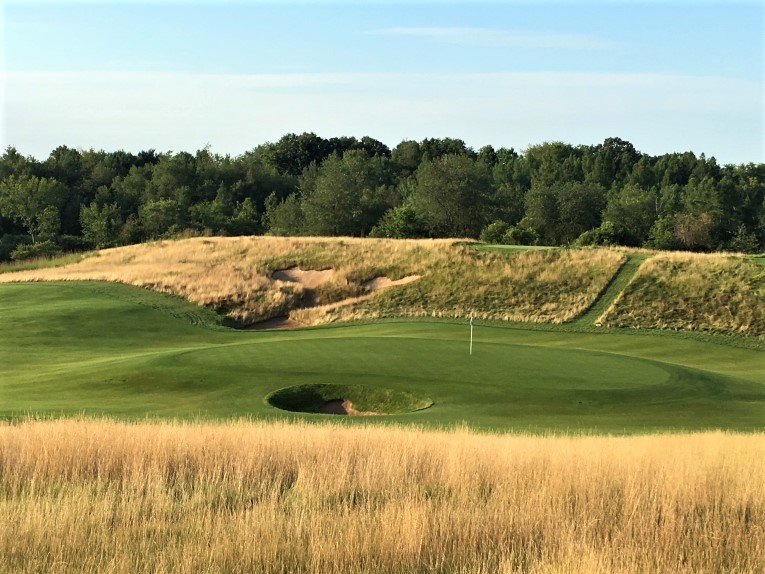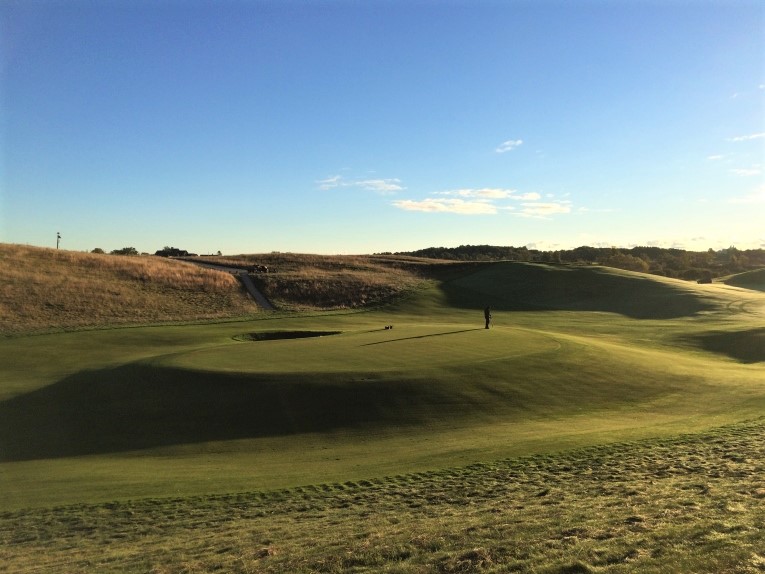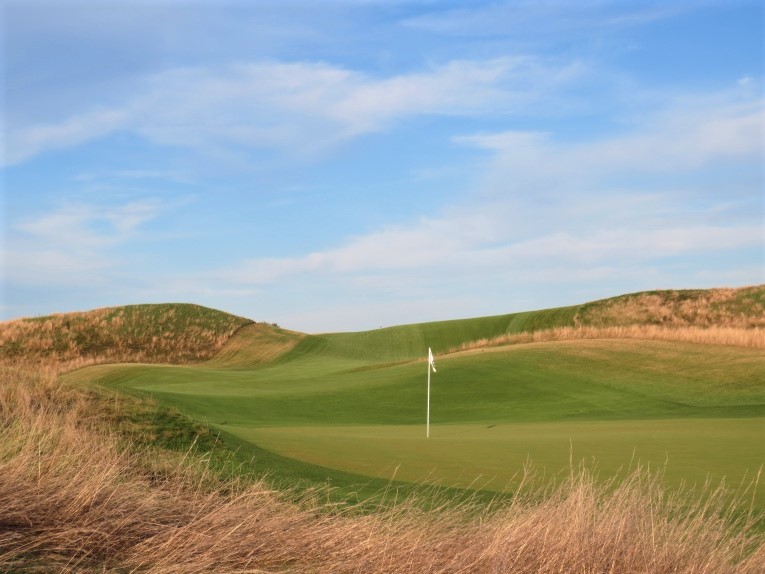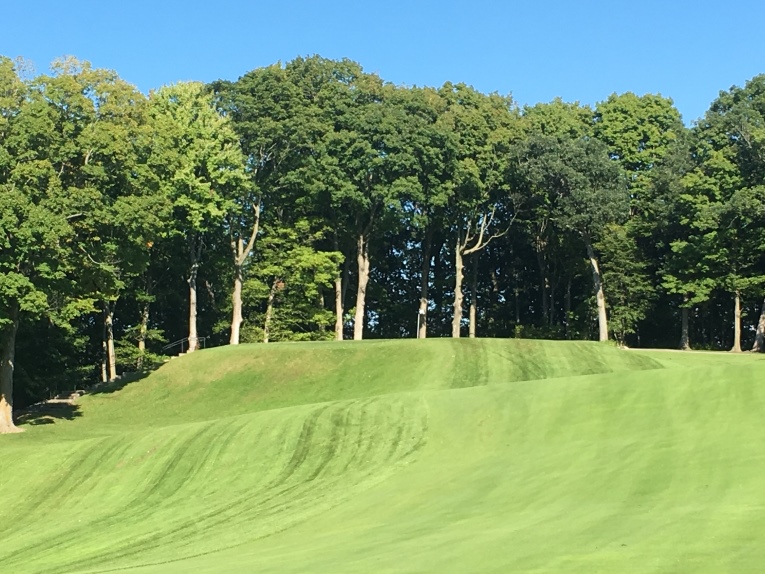Feature Interview with John Morrissett
June, 2017
John Morrissett helped Ran start GolfClubAtlas.com in 1998, worked in the USGA Rules Department from 1993 to 2010 and is presently the Director of Championships at Erin Hills. He hits the ball farther than his oldest brother but not quite as long as his middle brother.

Erin Hills will present an attractive test for the best in the world when it hosts the 2017 US Open.
Architecturally, what have been the three biggest changes to the course since it opened in 2006?
The three new greens (3, 4 and 10). The 3rd was rebuilt mainly because the upper level (which was not a reasonable target for a long par 4); the new green is much more receptive to a long, bouncing approach. The 4th green was originally a punchbowl that was pushed back to a much more demanding greensite on a small ridge with a wetland beyond. The original 10th green was a natural Biarritz but in an awkward position at the end of a very long three-shotter where the approach was usually blind (diminishing the ability to enjoy the green).
The elimination of the Dell Hole (the blind 7th) and the formalization of the bye hole into the 9th hole. The Dell Hole was an interesting experiment. It showed that many American golfers find the very principle of a blind par 3 unacceptable – when it is located in the U.S.; it is fascinating to hear many of the same players rave about the fun quirks of the Dell Hole at Lahinch and the Himalayas at Prestwick. I don’t quite understand how people can have both views, but at some point there is the good business practice of listening to what your customer wants and does not want. The elimination of the 7th hole allowed for the addition of a favorite hole (the 9th) and eliminated the awkward question of how to get from the 9th green (now the 8th) to the 10th tee.
The removal of more than 300 trees. When I played Erin Hills in 2006, four years before I started working here, I didn’t think there were many trees, but in old pictures the course looks like a forest compared to today. The tree removal allows the player to appreciate the great piece of land the course occupies and exposes the course even more to the wind (and this is a breezy spot).
As a future site representative, you have attended every U.S. Open from 2011-2016. You went to, among others, Chambers Bay, Pinehurst and Oakmont, three diverse courses and settings. Was it beneficial? What did the Erin Hills staff learn to help with the maintenance preparations for the U.S. Open?
While the climates, soil types and grasses vary tremendously, there are certain constants from which we learned invaluable lessons. For example, seeing what other courses do with staff size and the number of volunteers (which is a whole separate, amazing story – how superintendents and assistant superintendents from all over the world travel to the U.S. Open to volunteer their time and expertise); seeing staff organization ideas (e.g., having a staff member dedicated to the vendors to help them get around the course during the pre-championship period to minimize the damage to the course); seeing how other courses schedule the staff and volunteers (as there are morning and evening maintenance sessions).
For those not familiar with Erin Hills, what will strike them about the course during the U.S. Open?
The scale of the property, the natural landforms (shaped by glaciers), the wind, the bunkering (which yield few “normal” bunker shots), the native areas, and the strategic holes.
Let’s discuss that – what do you mean by “normal” bunker shots?
The bunkers follow the natural contours and have few flat bottoms. As a result, there are many shots from sidehill, uphill and downhill lies. In addition, the erosion style bunkers feature some fingers that become quite narrow in spots, leading to awkward stances and swings.
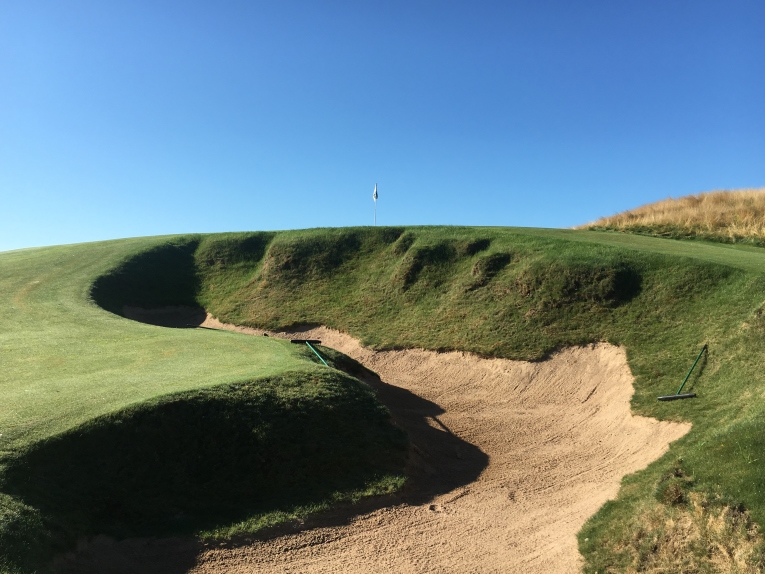
The hazards at Erin Hills are something to be avoided as there are no guarantees of being treated ‘fairly.’
What other design features do you most appreciate?
The pacing, from several perspectives, of the course stands out the most to me. For example, the middle of the course (holes 6-14) enjoys a stretch where no consecutive holes play in the same direction. In terms of difficulty, the pacing holds your attention. At the U.S. Open, the first two holes are birdie opportunities, while 3-10 is a solid stretch where the player needs to keep his game together. With its two par 5s and one short par 4, the last five holes present an opportunity for some late-round dramatics (in both positive and negative ways!).
Which are your three favorite holes?
I will start with the 2nd hole, because it showcases the natural landforms so well and is a fun, strategic hole. Depending on that day’s wind, from the tee a player can attempt to carry the bunkered ridge on the right to wind up on or near the green. Played as a two-shot hole, the player must hit the ball out of sight – literally – as a drive to the hidden left side allows a view of the green for the pitch. Even after playing the hole several times, it can be disconcerting to aim for an unseen target when there is so much visible fairway to the right (but which will leave a blind approach). The green is the smallest on the course at 3800 square feet and runs gently away from the player.
The 12th hole best captures the character of Erin Hills. The tee shot to the roller-coaster fairway is followed by an approach to a narrow green nestled between two hills. The back third of the green runs away from the player, making it challenging to get an approach (or even a putt from the front of the green) close to the hole; the player sometimes needs to realize that it is better to be a few yards over the green than it is to be on the front third of the green. It is fun to play the hole with newcomers to Erin Hills and to hear them say “Wow” as they crest the hill and see the vista with the green down below and the 14th and 15th holes beyond. The view from the green looking back towards the fairway spilling down the hill reminds me of the 11th hole at Ballybunion (Old) and is one of my favorite views on the course.
I love the 18th hole as it combines so many appealing elements. It is fun for a closing hole to offer a reasonable chance of a two-stroke swing, something that a stereotypical long par 4 closer does not do. In this case, a birdie-bogey combination is a real possibility. In addition to its length (675 from the tips), the hole features 24 bunkers (an interesting follow-up to the previous hole, which is bunkerless), a strategic second shot (how to handle the wide swing to the right and the center bunker), and perhaps the most precise approach shot on the course (with a false front, a cluster of bunkers on the left, and a fearsome, dramatic drop-off long and left. It is the rare par 5 where each shot matters and where 5 is an admirable score. Many cards have been wrecked on this hole. The fact that the hole lines up with the basilica at Holy Hill three miles away doesn’t hurt.
Let’s drill down on that answer. At 3,800 square feet, the 2nd green is among the smallest greens in the modern era for a U.S. Open venue. Do you have four good – and different – hole locations?
While the 2nd green is the smallest at Erin Hills, it would be a slightly above-average sized green at Pebble Beach! The green is large enough to provide a good variety of hole locations with different looks and challenges. For example, a front location emphasizes the turtle-back aspect of the green, as an approach that lands short will stay short (and will likely spin back down the hill some distance) while a back hole location plays up the front-to-back pitch of the green (as pitches don’t check as quickly). A hole location on the left brings into play the drop-off on the side, while a right hole location makes the player focus on the small bunker on that side (and can leave some very difficult pitches for bold tee shots that miss the green to the right).
People speak of the downhill, one shot 9th hole with a combination of admiration and dread. From the exposed, elevated tee, there is no escaping the wind. What is the most prudent way to play the hole? In its own way, do you consider the 9th as an island green?
Our caddies have famously dubbed the 9th as “the game’s shortest par 5,” and there’s a lot to that sentiment, as a player who misses the green (especially left or long) will often make a 5 or higher. The bunkering on the left side is some of the most punishing on the course, with narrow passes and awkward stances and lies to a green that slopes from front-to-back as well as from left-to-right. In an east wind (from the left), it is particularly challenging to hold the green from the tee and extremely difficult to find the green with a second shot from left of the green (where both the slope and wind will carry the ball away). It doesn’t play like an island green because there is a preferred side to miss it (to the right). Dana Fry, one of the architects (with Michael Hurdzan and Ron Whitten), played off the line for the par 3s at Rye and has said that the most difficult shot at Erin Hills is the second shot to the 9th.
You have worked at Erin Hills for seven years now and played the course over 75 times. Of which holes has your opinion changed the most? Why?
I remember playing the 1st hole in the early years, before I started working here, and not liking it one bit. Now, though, it is one my favorite holes. A cut was made to expose more of the landing area for the second shot, and a tree on the left was removed (a beautiful oak that was unfortunately in too-awkward of a location). I love just the feel of walking in the rolling landing area for the tee shot and think the final 60 yards of the hole is brilliant. It is the one hole that most encourages an approach along the ground. A player has room to use the sloping fairway to chase a long second shot onto the green, but he needs to place the ball just right or else face the wetland on the left or be left with a scary pitch from long and right of the green.
The par-5 7th hole has also grown on me a bit, especially after I finally learned to respect the hole and be grateful to walk away with a 5. The tee shot is the only one where the natural features don’t automatically train your eye to the desired line. On this exposed plain, it can be challenging to pick out the right line (even though the fairway is in full view; I can’t explain that paradox) and to aim oneself. The fairway, though, is a generous target. The second shot is a sleeper, both because the width of the landing area is modest (by Erin Hills standards) and is sometimes not entirely visible. Difficult bunkers on the right and thick fescue on the left make finding the fairway a must if the third is going to get home. The difficulty of the second shot is further compounded by the nagging thought that you wish you could lay up closer to the green than 100 yards. The two center bunkers dug into the hillside leading up to the green force the player to make an all-or-nothing decision with his second shot, and usually the green is too far away for the player to entertain thoughts of going for it in two. The largest on the course at 10,900 square feet, the green was originally designed to handle a brawny two-shotter that often played into the wind. However, the bold contours of the green ensure that taking two shots from 100 yards is quite an accomplishment. The back-to-front slope of the left side make it one of the nervier spots on the course to putt, as you can suddenly find yourself with a long second putt.
What is the wind situation at Erin Hills in June?
It can vary quite a bit. The wind usually doesn’t settle into its prevailing pattern from the west until July. It would not be a surprise to see at least two different wind directions during the U.S. Open. I remember one almost scary time: The day after the 2013 U.S. Open, I was playing a media event we hosted; while we were on the 16th green (3-4 minutes), the wind shifted from west to east and the temperature dropped at least ten degrees!
As much as any state in the country, Wisconsin has transformed itself in the past twenty years into a golf destination. To what do you attribute its rise?
Wisconsin has a tremendous variety of natural settings. Consider these four prominent courses and their dramatically different terrain: Whistling Straits enjoys several miles of property along Lake Michigan (which, to those not familiar with the Great Lakes, could easily be mistaken for an ocean if not for the lack of that salt-air smell); Blackwolf Run (River) incorporates the Sheboygan River into more than half (!) its holes; Sand Valley occupies sand dunes; and Erin Hills is set in the Kettle Moraine, shaped by glaciers. Mr. Kohler started the championship golf movement in Wisconsin, with his Blackwolf Run hosting the 1998 and 2012 U.S. Women’s Opens and Whistling Straits (Straits) hosting an amazing three PGA Championships in just an 11-year run, as well as the U.S. Senior Open. Erin Hills followed suit, by hosting the state’s first U.S. Amateur in 2011 and first U.S. Open this year. The golf world has quickly appreciated the wonderful courses (so many of which are open to the public), pleasant climate for summer golf, the enthusiasm of Wisconsinites for sports and the outdoors, the warm hospitality of Wisconsin residents, and the support of the state and local governments.
Sand Valley, Kohler and Erin Hills are all obvious ‘must-plays.’ Where else in Wisconsin do you recommend in terms of hidden gems we might not have heard of?
I know its praises are frequently sung on this website, but I cannot overstate how much I love Lawsonia (Links). A nice (but not special) piece of property, a feeling of openness, an amazing set of greens, and one really good and appealing hole after another. The course is in good hands, as evidenced by recent tree removal that has the course somehow managing to get better and better with each visit.

The complete elimination of the trees on the left allows the 14th at Lawsonia to shine again and for its green complex to be fully appreciated.
Somewhat overshadowed by its neighbors at Blackwolf Run and Whistling Straits, the Bull at Pinehurst Farms is one of Jack Nicklaus’s best designs. There is a lot to like on that course.
Quit Qui Oc in Elkhart Lake has a handful of exceptional holes where the glacier-shaped terrain was used to great effect.
It’s a private club, but West Bend Country Club is a Langford and Moreau design featuring a few of the best holes in the state. Some wild greens. The short two-shot 7th is larger than life.
Off topic: As the USGA’s former Director, Rules of Golf, what do you think about the proposed Rules changes for 2019?
The R&A and USGA are doing a wonderful job with this project. The content is very good, but what is especially impressive is the style and format. Many people won’t appreciate how difficult it can be to take a thought and to transfer that idea into airtight but understandable text. The two bodies did an exceptional job on that front with the language and format (e.g., the use of bullet points).
Good luck!
The End


